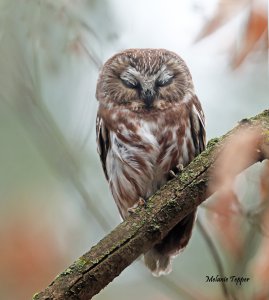Northern Saw-Whet Owl Glows

Northern Saw-Whet Owl Glows
You never know what secrets an animal might keep up its sleeves, or in this case, under its wings. This Northern Saw-Whet Owl was admitted in late November with concussion symptoms. With a treatment plan that included medication, rest, and nutrient dense foods, we were pleased that this bird progressed quickly back into good health.
Northern Saw-Whet Owls are a species being studied to learn more about their migration habits and populations. Executive Director and Lead Wildlife Rehabilitator, Carol Holmgren, worked with TWC Board President and Executive Director of the Erie Bird Observatory, Sarah Sargent, to band this bird. Determining its age and gender would add to the banding data. It was during this examination and banding session that this little owl shared its photoluminescent secret with us.
The Examination and Why Feathers Glow

Measuring the bird’s weight and wing length allowed Carol and Sarah to determine the owl is female, the larger of the sexes in owls. Sarah suggested using a blacklight to observe the bird’s feathers for evidence of fluorescence. As the room lights turned off and the blacklight turned on, this little bird put on a bright pink show for observers. The ultraviolet (UV) light produced by the blacklight caused the porphyrin pigments in the feathers to glow the fluorescent pink color.
This pigment in bird feathers is responsible for causing feathers to be red, brown, green, and even pink without the presence of UV light. With many owl species, the brown colors seen on their feathers are caused by combinations of melanins and porphyrins in their feathers.
While human eyes cannot see the UV light spectrum without specialized tools, bird eyes are adapted to easily see this type of light. Like humans, birds have cone cells in their eyes that specialize in detecting the colors red, green, and blue. Unlike humans, birds have a fourth type of cone that is specialized for detecting UV wavelengths.
Other species of birds, like parakeets and parrots, display luminous feathers on their faces or crowns that help them to attract mates. In the case of owls, it is not known what benefit it is to be able to see the feathers of other owls. What we do know is that scientists can use the pattern of luminescent color on the wings to estimate the bird’s age. The pigment fades with exposure to sunlight, so newly grown feathers glow more brightly than older ones.
Owls only molt only certain flight feathers each year, so identifying which are new feathers and which are old, allows us to age the bird. Because all of this bird’s feathers glowed with equal brilliance, it was clear they were grown in at the same time: a tell tale sign of a young owl. Only newly hatched owls grow in a complete set of new flight feathers in one year. Carol and Sarah were thus able to determine that this patient hatched in the spring 2022.
Released Back to the Wild
It is typically difficult to determine the age of bird patients if they are admitted as adults. This extra glowing diagnostic tool helped the TWC team to make important decisions about the treatment plan for this owl. After recuperating at Tamarack, this owl was released at dusk. She was transported further south in Pennsylvania for release because this species of owl had already migrated through the TWC area for the winter. The Tamarack team was happy to help her make up some of the ground she would have covered while she was in treatment.
to help her make up some of the ground she would have covered while she was in treatment.
Photographer, Melanie Tepper, remained onsite after the release and from a distance, was able to watch this little owl acclimating to its immediate surroundings. As the owl became comfortable on her perch, she closed her eyes for periods of time. Then, as night fell, she became more active, scanning her surroundings intently before flying off into a grove of pines. We wish this young owl all the best as she continues to make her way in this big world that we all share.
Did You Know?
Northern Saw-Whet Owls are the smallest of Pennsylvania’s 8 resident owls. This petite owl has an average wingspan of 7-8 inches and weighs up to 5 ounces. At that weight, these owls are lighter than a standard baseball. Their main prey items include small mammals like mice and shrews that they hunt for from low perches near the edges of forests. Preferring forest habitats, this species breeds exclusively in forests and tend to prefer coniferous trees.
Recent Posts
Young Eagle is Saved, Healed, and Released to Join New Family!
Article written by Keith Gushard and originally published in the Meadville Tribune on July 12, 2024 A young bald eagle is now part of a new eagle family following successful…
Read Post >An Eagle’s Journey to Recovery and Release
We are very excited to share that a 3 year old Bald Eagle nicknamed “Hera” (patient 23-1189) is ready for release following 9 months of treatment. Hera has had a…
Read Post >

